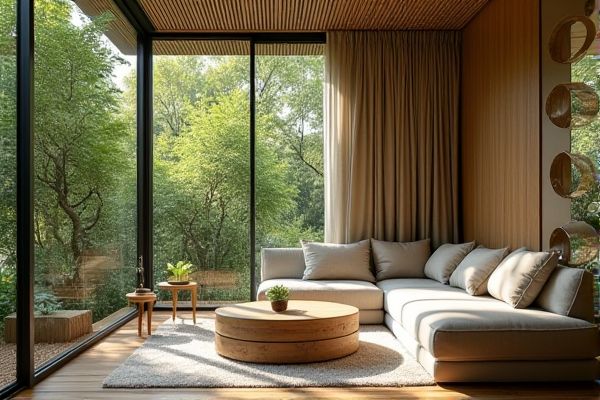
Artificial bamboo offers consistent durability and low maintenance compared to natural bamboo, which is prized for its eco-friendliness and authentic aesthetic but requires more care. Explore the key differences and benefits to determine which type best suits your needs in the full article.
Table of Comparison
| Feature | Artificial Bamboo | Natural Bamboo |
|---|---|---|
| Material | Plastic, resin, or synthetic fibers | Natural bamboo stalks and fibers |
| Durability | Resistant to pests and rot, long-lasting | Susceptible to pests, rot, and weather damage |
| Maintenance | Low maintenance, easy to clean | Requires regular treatment and care |
| Environmental Impact | Non-biodegradable, potential plastic waste | Biodegradable, renewable resource |
| Appearance | Uniform, available in various colors and styles | Natural color variations, unique patterns |
| Cost | Generally lower upfront cost | Varies, can be higher due to harvesting and processing |
| Use Cases | Decor, fencing, furniture, low-moisture environments | Construction, furniture, flooring, sustainable building |
Introduction to Artificial vs Natural Bamboo
Artificial bamboo, made from synthetic materials like plastic or resin, mimics the appearance of natural bamboo but offers higher durability and resistance to weather, pests, and rotting. Natural bamboo is a fast-growing, renewable plant known for its strength, flexibility, and eco-friendly properties, commonly used in construction, furniture, and decor. Choosing between artificial and natural bamboo depends on factors such as maintenance needs, environmental impact, lifespan, and application.
Material Composition and Manufacturing
Artificial bamboo is typically made from composite materials such as high-density polyethylene (HDPE) combined with wood fibers or recycled plastics, engineered through extrusion or molding processes to mimic the appearance of natural bamboo. Natural bamboo consists of cellulose-based fibers, lignin, and moisture, harvested directly from bamboo plants and processed through drying and curing to preserve its strength and flexibility. Your choice between artificial and natural bamboo should consider factors like environmental impact, durability, and maintenance needs linked to their distinct material compositions and manufacturing methods.
Environmental Impact and Sustainability
Artificial bamboo typically has a higher environmental impact than natural bamboo due to its production processes involving synthetic materials and non-biodegradable components. Natural bamboo is highly sustainable, growing rapidly without the need for pesticides or fertilizers, and it absorbs significant amounts of CO2, making it an eco-friendly choice. Choosing natural bamboo supports sustainable forestry and reduces your carbon footprint through renewable, biodegradable resources.
Durability and Longevity
Artificial bamboo outperforms natural bamboo in durability due to its resistance to rot, pests, and moisture, making it ideal for outdoor applications. Unlike natural bamboo, which can degrade over time when exposed to harsh weather conditions, artificial bamboo maintains its structural integrity and appearance for decades. This enhanced longevity reduces maintenance costs and replacement frequency, providing a sustainable alternative to natural bamboo in construction and design.
Aesthetic Differences
Artificial bamboo often features uniform color and texture, providing a consistent and polished appearance, while natural bamboo showcases unique variations and organic imperfections that add character and authenticity to your space. The natural grain and nodes of real bamboo create a warm, rustic aesthetic that artificial versions may struggle to replicate accurately. Choosing between the two depends on whether you prioritize the flawless finish of artificial bamboo or the distinctive, natural beauty of authentic bamboo.
Maintenance and Care Requirements
Artificial bamboo requires minimal maintenance, needing only occasional cleaning with a damp cloth to remove dust and dirt, making it ideal for busy lifestyles. Natural bamboo demands more care, including regular watering, protection from excessive moisture to prevent mold, and occasional treatment with sealants or oils to maintain its durability and appearance. Your choice between the two should consider the time and effort you can dedicate to upkeep along with your desired aesthetic.
Cost Comparison
Artificial bamboo generally incurs higher upfront costs compared to natural bamboo due to manufacturing expenses and synthetic materials. However, your long-term investment may favor artificial bamboo as it requires less maintenance, resists weather damage, and lasts longer. Natural bamboo is more affordable initially but often demands regular treatment and replacement, increasing overall expenses over time.
Popular Applications and Uses
Artificial bamboo is widely used in interior design, landscaping, and furniture production due to its durability, low maintenance, and resistance to pests and weather. Natural bamboo remains popular for construction, traditional crafts, and eco-friendly products because of its renewable growth and strength. Both materials find application in flooring, fencing, and decorative elements, with artificial bamboo favored for consistent appearance and natural bamboo prized for sustainability.
Health and Safety Considerations
Artificial bamboo offers a safer alternative to natural bamboo by eliminating pests, mold, and chemical treatments often present in natural bamboo that can trigger allergies or respiratory issues. Natural bamboo may contain pesticides or fungicides used during cultivation, which pose health risks especially to individuals with chemical sensitivities. Your choice between artificial and natural bamboo should consider these health and safety factors alongside environmental preferences.
Which Bamboo is Right for You?
Artificial bamboo offers durability, low maintenance, and resistance to pests and weather, making it ideal for long-lasting decorative or privacy screens. Natural bamboo provides authentic aesthetics, environmental benefits, and the ability to grow and adapt in your garden, perfect for sustainable landscaping projects. Your choice depends on whether you prioritize convenience and longevity or ecological impact and natural growth.
 homyna.com
homyna.com